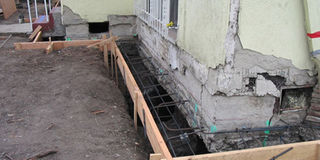Mistakes that lead to cracks in foundation

Cracked foundations can be repaired in order to avoid total loss.
When cracks and leaks show up, you’ve already created or ignored problems that damage foundations.
Here are some mistakes that can cause foundation woes and, if unresolved, can make matters worse.
Grading gaffes
Poor soil excavation can direct water toward the base of your house and through foundation walls.
Make sure your yard is graded at least 6 inches in 10 feet so soil slopes away from your house.
How do you check the slope? Use a level. Put one end where the ground meets your foundation wall, and level the tool. Measure the space from the other end of the level to the ground.
If you use a 2-foot level, multiply your findings by five. Say you measure a 2-inch gap.
That means over 10 feet, you’ll have a slope of about 10 inches — good enough.
If there’s no space, you need to create slope.
By the way, 10 feet is enough to move water away from your foundation, even if the soil after that distance slopes back up the other way.
You may have to build up a berm, dig a trench, or install a French drain to funnel rainwater and runoff away from your home.
Also, be careful when you apply mulch on foundation plants. Make sure that slopes away from your home, too.
Downspout downer

Cracked foundations usually lead to cracked walls and must be attended to as soon as possible.
Downspouts should direct rain and roof runoff away from your house. But if you don’t extend the downspout five to 10 feet away from the house, you’ll dump water on your foundation.
You can buy extenders from plain to fancy. Or bury a long downspout diverter underground and drain the water to the curb, a storm drain, or to a spot in your yard where the water will percolate into the soil.
Water woes
Avoid letting the soil around your house completely dry out and shrink during a long dry spell.
The next big rain could soak the soil, making it expand dramatically and putting stress on your foundation walls.
In drought, run a soaker hose around your house at least six inches from the foundation and three inches under the soil. That should help quiet soil contraction and expansion.
Root riots
Tree and shrub roots can compete with your soil for moisture during drought, causing your foundation to settle and sink unevenly.
When that happens, drywall can crack and windows and doors will stick in their frames.
To prevent a war for water, plant deep-rooted trees and shrubs away from the house. If the branches touch the house, the tree is too close.
Foundation repairs and sealing cracks
If your foundation has cracks wider than 1/4-inch wide, or if you have stairstep cracks in blocks or bricks, you need to fix the underlying problem as soon as possible. The most common culprit is water. It can accumulate in the soil around the foundation, which expands the soil and puts pressure on walls and foundation footings, causing cracks to appear.
Check to make sure all gutters and downspout drains are in good working order, and that the soil around your foundation is properly graded — it should slope at least 6 inches for every 10 horizontal feet.
Most foundations are required to have a perimeter drain system, such as a French drain, that channels sub-surface water away from the foundation.
It’s possible for this drain to become blocked, causing water to accumulate in the soil and putting pressure on your foundation walls. If you suspect a blocked drain, you will need to hire a professional to unclog it.
If your foundation is uneven

A foundation that has tipped, bowed, or severely cracked requires substantial reinforcement to prevent further deterioration.
Repair the walls from the inside with wood or steel braces, carbon-fiber mesh, or wall anchors spaced 6 feet or so apart along the entire wall.
For about $500 to $700 each, wood and steel braces install against the wall and attach to the floor and overhead joists, blocking further movement. However, they intrude into the basement area about 6 inches, making it difficult to finish the walls.
A newer option, which costs less than half as much and winds up almost invisible, involves spreading epoxy in vertical strips and then pressing on carbon-fiber mesh to lock the wall in place.
Wall anchors are similar to large bolts.
They consist of metal plates in your yard (installed by excavating) and metal plates on the inside of your foundation walls. The plates are connected by steel rods buried horizontally. The connectors are gradually tightened to stabilize and help straighten the wall.
Wall anchors are placed every 6-8 feet, and cost Shs1million each. If a foundation wall bows severely (more than 3 inches) or if you want to make it straight again, you probably won’t be able to fix the problem from the inside.
You will probably need to excavate part or all of the foundation and rebuild it.
If part of your foundation is washed out
If a broken water pipe, a plugged gutter, or a drainage problem in your yard sent enough water cascading alongside a perimeter foundation to undermine an area, a contractor might be able to shore up the area with more concrete or shim the sill plate to make the area level again.
Or you might need to tear out a section of the foundation, re-pour, and tie the new section into the old with rebar and epoxy.
Simple fixes with concrete and lumber might cost as little as Shs1m or as much as several millions.
Just be sure that the underlying cause is fixed first, or the repair won’t last.




